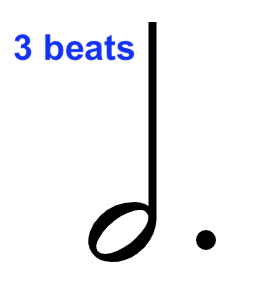Most of us who were ever in elementary school music class, dabbled in middle school band or watched the music segments of Sesame Street are vaguely familiar with basic rhythm. (But just in case, here's a quick review...)
However, things get a little wonky when we let RESTS, DOTS and TIES, come into our measures. All of the sudden, counting isn't as straight forward, we're constantly coming in at the wrong time and they are making us feel self conscious about our ability to do simple math. Let's beat that fear, so we're never in a chorus just waiting for someone else to come in because we're not really sure what beat we enter on...(and then all of the sudden the entire soprano section is silent for insecurity in counting)
Let's check in with RESTS first. A rest represents moments of silence in a piece of music. Each of them shares a duration with their corresponding notes. For example, a quarter note is worth 1 beat and a quarter rest is one beat of silence. Here's what they all look like...
Just like notes (8ths and 16ths being the most common) - rests can have flags. One flag represents an 8th note, two flags a 16th, etc) pictured below:
------------------------------------------------------------------------------------------------------------------------------
Still with me?? Let's move on to DOTS and TIES. Both are a way to elongate a notes duration (and also fun ways to make fashion statements)
A dot increases the duration by 1/2 of the note value that comes before it. While that sounds complicated, it's not too crazy. If a quarter note is worth 1 beat, and we add a dotted 1 ÷ 2 = 1/2, so 1 +1/2 = 1.5 beats.
Even more simple as an example is a dotted half note. A regular half note is 2. Half of 2 is 1. 1 + 2 = 3 beats.
Thankfully a dot is ALWAYS worth one half of the note value that comes before it. Just sometimes it takes a little math.
-------------------------------------------------------------------------------------------------------------------------------
And our last little music theory friend for the day - TIES. Ties are a way augment the duration of a note across bar lines. They always merge two notes of the same pitch. They do not alter the way that we count the measures, but it does mean that we hold the notes for the duration of both notes that are tied together, rather than replaying the same pitch.
Any type of a note can be tied, and often times you'll see notes of long duration (such as whole notes at the end of a song) tied together multiple times, simply to tell us to hold a beat for a certain number of beats.
For example - here are two whole notes tied together. If one whole note is worth 4 beats, and its tied to another whole note worth 4 beats - we simply hold the note for 8 beats. Easy as pie!
Now that you've gotten a taste for RESTS, DOTS and TIES (basically the three things that make our rhythms a little spicer) you can walk into those sight reading auditions or choir rehearsals and count out those beats so you enter STRONG and hopefully avoid the dreaded chorister entrance that is strong and WRONG.













No comments:
Post a Comment